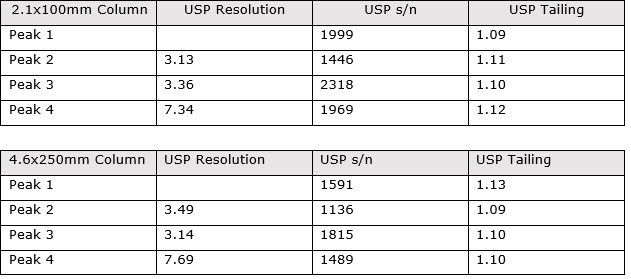Back
Purpose: With changes to regulatory guidance, scaling of HPLC methods to sub 2-µm columns can increase throughput and reduce solvent consumption, improving sustainability. However, when scaling methods to lower particle columns on a system capable of housing 250 mm columns, instrument characteristics, such as extra-column volume, can impact sensitivity and peak width. By optimizing the pre and post-column tubing, increase in performance can be realized for not only sub-2µm but also HPLC columns.
Methods: In this study, two HPLC analyses were scaled to sub-2µm columns of varying dimensions. For each column the impact of pre- and post-column tubing ID was evaluated on a single system capable of switching between multiple columns. With each combination of column and tubing ID, system characteristics were measured including dwell volume, and extra column volume. The methods included a gradient separation of flavonoids, as well as a USP monograph. The performance of each method was assessed by system suitability parameters (resolution, signal-to-noise). Studies also evaluated the impact and limitations of tubing configurations, specifically the impact of using larger ID tubing with smaller bore, sub-2µm columns.
Results: Chromatographic results on both sets of columns demonstrated comparable performance using the smaller ID tubing with the sub 2-µm columns and the larger ID tubing with the HPLC column. For the flavonoid gradient separation, all method acceptance criteria were met including USP tailing of less than 1.1, USP resolutions greater than 3.1, and signal-to-noise greater than 1100 for all peaks. In addition, scaling to the 2.1 mm columns allowed for a decrease in run time of 86% with 86% lower solvent consumption (Figure 1 and Figure 2). Analysis of the USP method also demonstrated that it met system suitability requirements while scaling HPLC to the appropriate sub-2µm column. The impact and limitation of the pre and post column tubing on chromatographic performance was successfully demonstrated.
Conclusion: Scaling of HPLC methods to sub 2-µm columns improved throughput, reduced solvent consumption by 50%, and improved sustainability. By optimizing the pre and post-column tubing, performance (resolution, signal-to-noise) was improved for not only sub-2µm but also for HPLC columns.
.jpg)
Figure 1: Gradient analysis of flavonoids on a single system with the combinations of a 4.6 ID column with larger ID tubing and 2.1 mm ID column with smaller ID column. Method was scaled for flow rate and gradient steps.

Figure 2: For the flavonoid gradient separation, all method acceptance criteria were met including USP tailing of less than 1.1, USP resolutions greater than 3.1, and signal-to-noise greater than 1100 for all peaks.
Manufacturing and Analytical Characterization - Chemical - Analytical
Category: Poster Abstract
(M1530-06-32) Considerations and Impact of Extra-Column Volume on the Analysis and Scaling of a HPLC Separation
Monday, October 17, 2022
3:30 PM – 4:30 PM ET
- PH
Paula Hong, Ph.D.
Waters Corporation
Milford, Massachusetts, United States - AS
Aisha Siddiqua, BS
Waters Corporation
Milford, Massachusetts, United States
Presenting Author(s)
Main Author(s)
Purpose: With changes to regulatory guidance, scaling of HPLC methods to sub 2-µm columns can increase throughput and reduce solvent consumption, improving sustainability. However, when scaling methods to lower particle columns on a system capable of housing 250 mm columns, instrument characteristics, such as extra-column volume, can impact sensitivity and peak width. By optimizing the pre and post-column tubing, increase in performance can be realized for not only sub-2µm but also HPLC columns.
Methods: In this study, two HPLC analyses were scaled to sub-2µm columns of varying dimensions. For each column the impact of pre- and post-column tubing ID was evaluated on a single system capable of switching between multiple columns. With each combination of column and tubing ID, system characteristics were measured including dwell volume, and extra column volume. The methods included a gradient separation of flavonoids, as well as a USP monograph. The performance of each method was assessed by system suitability parameters (resolution, signal-to-noise). Studies also evaluated the impact and limitations of tubing configurations, specifically the impact of using larger ID tubing with smaller bore, sub-2µm columns.
Results: Chromatographic results on both sets of columns demonstrated comparable performance using the smaller ID tubing with the sub 2-µm columns and the larger ID tubing with the HPLC column. For the flavonoid gradient separation, all method acceptance criteria were met including USP tailing of less than 1.1, USP resolutions greater than 3.1, and signal-to-noise greater than 1100 for all peaks. In addition, scaling to the 2.1 mm columns allowed for a decrease in run time of 86% with 86% lower solvent consumption (Figure 1 and Figure 2). Analysis of the USP method also demonstrated that it met system suitability requirements while scaling HPLC to the appropriate sub-2µm column. The impact and limitation of the pre and post column tubing on chromatographic performance was successfully demonstrated.
Conclusion: Scaling of HPLC methods to sub 2-µm columns improved throughput, reduced solvent consumption by 50%, and improved sustainability. By optimizing the pre and post-column tubing, performance (resolution, signal-to-noise) was improved for not only sub-2µm but also for HPLC columns.
.jpg)
Figure 1: Gradient analysis of flavonoids on a single system with the combinations of a 4.6 ID column with larger ID tubing and 2.1 mm ID column with smaller ID column. Method was scaled for flow rate and gradient steps.

Figure 2: For the flavonoid gradient separation, all method acceptance criteria were met including USP tailing of less than 1.1, USP resolutions greater than 3.1, and signal-to-noise greater than 1100 for all peaks.
